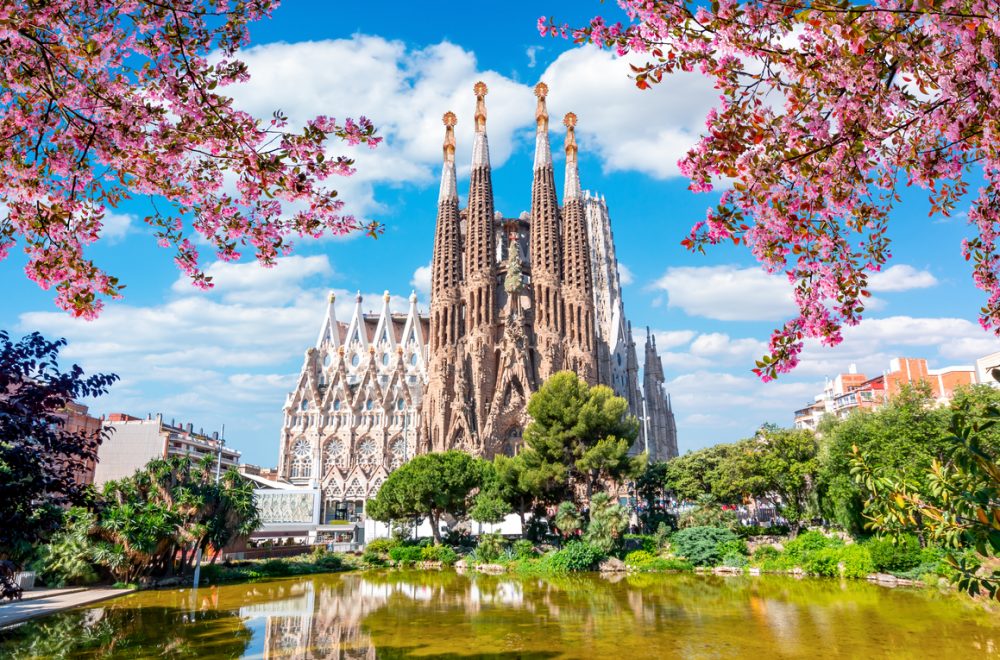
The Best Gaudí Architecture in Barcelona You Can’t Miss
Want to see the best architecture in Barcelona? You’ll certainly see designs by the city’s best-known architect, Antoni Gaudí. The man is so famous in Barcelona that, like Cher or Madonna, he’s simply known as Gaudí. And his awe-inspiring buildings aren’t just the top tourist attractions in Barcelona, but in all of Spain.
From the still-unfinished Sagrada Família (it’s now projected to be completed in 2026) to the lesser-known Bellesguard Tower, I’ll tell you where to see Gaudí’s influence in Barcelona, how to visit the best Gaudí landmarks, and what symbols and themes to look out for in his work.
Who was Antoni Gaudí?
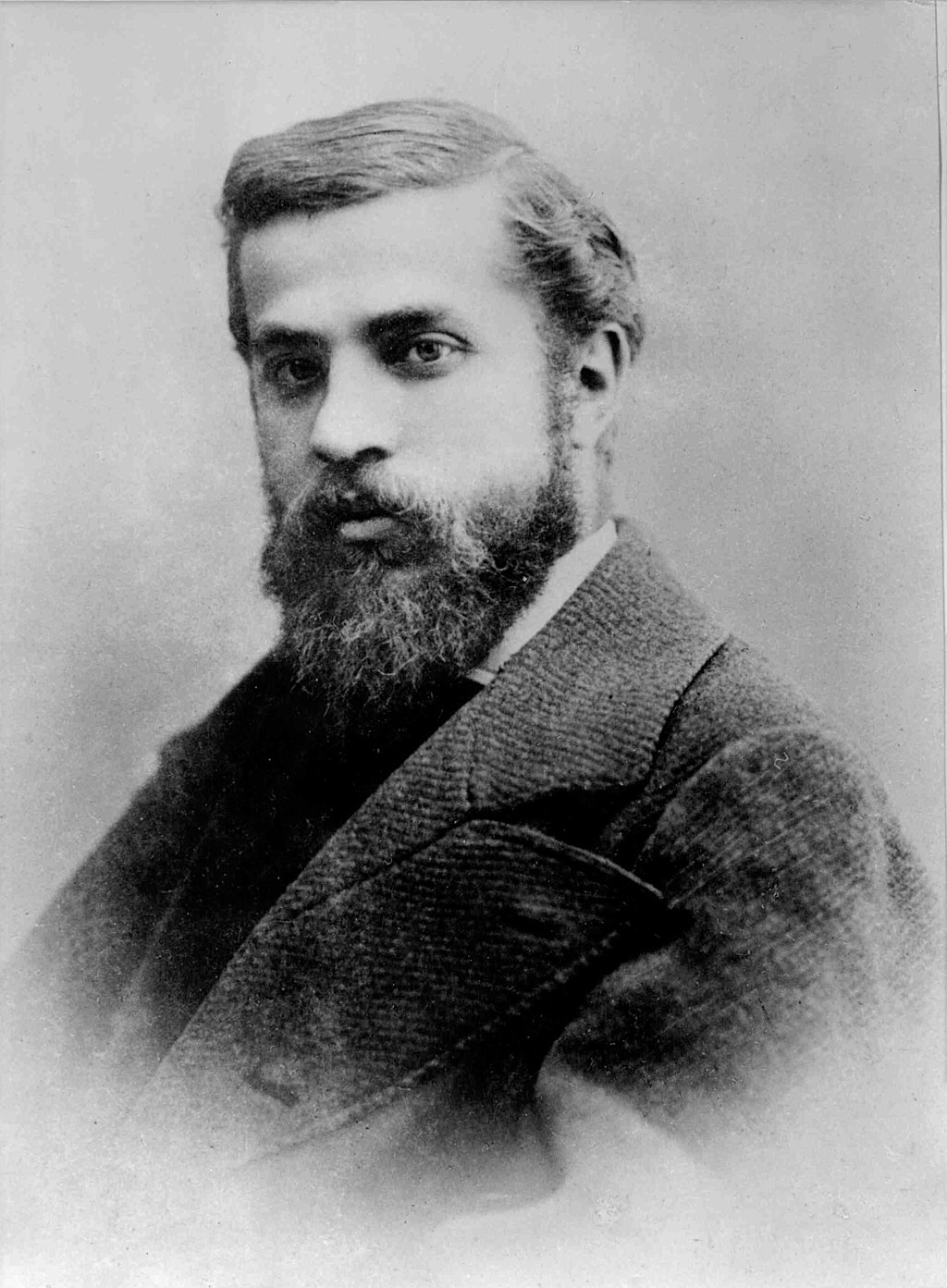
First off, let’s talk about who this guy is. Or was.
Born in 1852, the Catalan architect came from a family of metalsmiths, which helped him develop skills for working with volume and space. He showed early promise for transforming everyday materials into extraordinary creations that inhabited every part of a space.
Gaudí moved to Barcelona around 1870 to study architecture, where his unique talent and vision were quickly recognized but also led the director of the program to wonder, “I don’t know if we have awarded this degree to a madman or a genius; only time will tell.”
Time did soon tell as Gaudí accepted commissions to build private residences for wealthy businessmen like Eusebi Güell. But his influence can be felt in even the smallest details of the city — not just his major works — like the Gràcia lampposts and his contribution to the Cascada Monumental in Ciutadella Park.
Gaudí made lasting contributions to “Modernisme” (the Catalan Modernism movement) with his “trencadis” technique of breaking up mosaic tiles and arranging them asymmetrically. He would use this method to add color to the organic shapes used in his works.
A devout Catholic, Gaudí’s greatest achievement is the Sagrada Família, which remains unfinished today. Since he accepted the commission to build the church in 1883, his piety only grew and led him to abandon all other projects to focus solely on what is considered his greatest masterpiece.
Unfortunately, Gaudí didn’t live to complete his vision of the Sagrada Família — he was killed by a trolley car in 1926. The work on the basilica continues today, and no trip to Barcelona is complete without exploring the many architectural marvels of Antoni Gaudí.
Fun fact: Seven of Gaudí’s buildings in or around Barcelona are UNESCO World Heritage sites because of their contribution to architecture, art, and technology:
- Park Güell
- Palau Güell
- Casa Casa Milà
- Casa Vicens
- Casa Batlló
- the Nativity façade and crypt of the Sagrada Família
- the crypt in Colonia Güell just outside of Barcelona
Where to see Gaudí’s buildings in Barcelona
You don’t have to go far in Barcelona to find examples of Gaudí’s stunning architecture. His major works are mainly located in Barcelona’s Gràcia and Sarrià-Sant Gervasi neighborhoods, but you’ll see his influence all over the city. We’ll tell you how to look out for them!
1. Sagrada Família
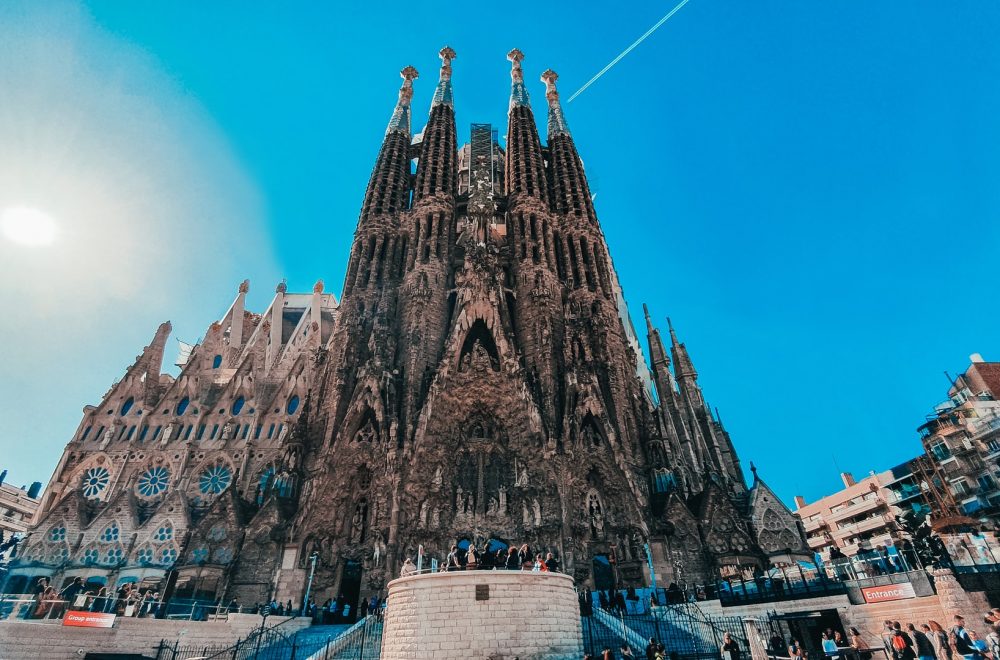
It’s no secret that Gaudí’s Sagrada Família has been a work in progress since its construction began in 1882. At the time of the architect’s tragic untimely death, only a quarter of the work had been completed.
Complete or not, the Sagrada Família is a church like no other and Spain’s most popular landmark, attracting almost 3 million visitors each year. And if you’re planning to visit Barcelona in 2026, the work to reach Gaudí’s vision is expected to be finished — it will also be the 100th anniversary of the architect’s death.
Why you should visit: A masterpiece of modernist architecture, you won’t be able to keep yourself from saying “wow!” when you see the castle-like Catholic church for the first time. It is designed to tell a story, which you’ll see unfold as you walk around the exterior and interior.
What to look out for: On the outside, pay close attention to the three façades that reflect key moments in Christ’s life:
- the Nativity (his birth)
- the Passion (the crucifixion)
- the Glory (in heaven)
There are also 18 towers that represent the Virgin Mary, the apostles, the evangelists, and Jesus Christ himself. Christ’s tower has yet to be completed, but it will measure 566 feet once it is, making Sagrada Família the tallest church in the world.
Step inside, and you’ll feel like you’re walking through a rainforest with its tree-like columns and stained-glass windows that filter the brightness of the sunlight that shines through.
How to visit: Reserve a ticket online or book a tour in advance. It’s open every day, but opening and closing times vary by season.
Getting to the Sagrada Família is easy with public transportation:
- Metro: L2 or L5
- Bus: 19, 33, 34, D50, H10 or B24
Remember to dress appropriately, as it is a place of worship. Hats are not allowed, shoulders must be covered, and shorts and skirts should come to your mid thigh.
2. Park Güell

Step inside the world of Gaudí’s imagination at Park Güell, an example of what a genius can do when they’re given creative freedom. That’s exactly what the Catalan industrialist Eusebi Güell gave Gaudí when he commissioned him to design a housing community for Barcelona’s rich.
Güell and Gaudí’s working relationship began in the late 19th century, after Güell first saw the architect’s work at the Paris Universal Exhibition of 1878. The idea for this housing project was to get prominent families to buy one of the 60 plots of land and build a house. Despite the fresh air and beautiful views of the Collserola mountains, the idea didn’t catch on. By 1914, only Güell and Gaudí had purchased land, Eusebi Güell died in 1918, and the community became a large private garden.
Today, Park Güell is an UNESCO World Heritage site that’s open to the public and attracts millions of visitors a year with its mix of whimsy, modernism, and nature.
Why you should visit: You’ll see why Gaudí’s creation is sometimes called “a playground for the mind.” He wanted to stay true to the landscape, so all of the park’s structures mimic or seem to grow from it. Nature was also a source of inspiration for Gaudí, as is functionalism — you’ll discover how everything he designed had a functional purpose for the housing community Park Güell was meant to be.
What to look out for: The dragon stairway and serpentine bench might be the most photographed sites in the park. Both are examples of the “trencadís” (Catalan for “broken up”) mosaic technique that’s prominent in Gaudí’s work. It consists of breaking up mosaic tiles into tiny shards that are laid asymmetrically.
How to visit: A limited number of visitors can enter the park each day, so tickets must be reserved ahead of time. You can only enter at the time on your ticket, but you can stay until closing once you’re inside the park.
Park Güell is located up a hill in the El Carmel neighborhood of Barcelona. The metro L3 line will get you close to the park, but you’ll still have to walk 20 minutes. The H6 or D40 buses will get you closer — about 10 minutes away. Bus lines 24 and 92 will also drop you right across from the park’s main entrance.
3. Casa Batlló
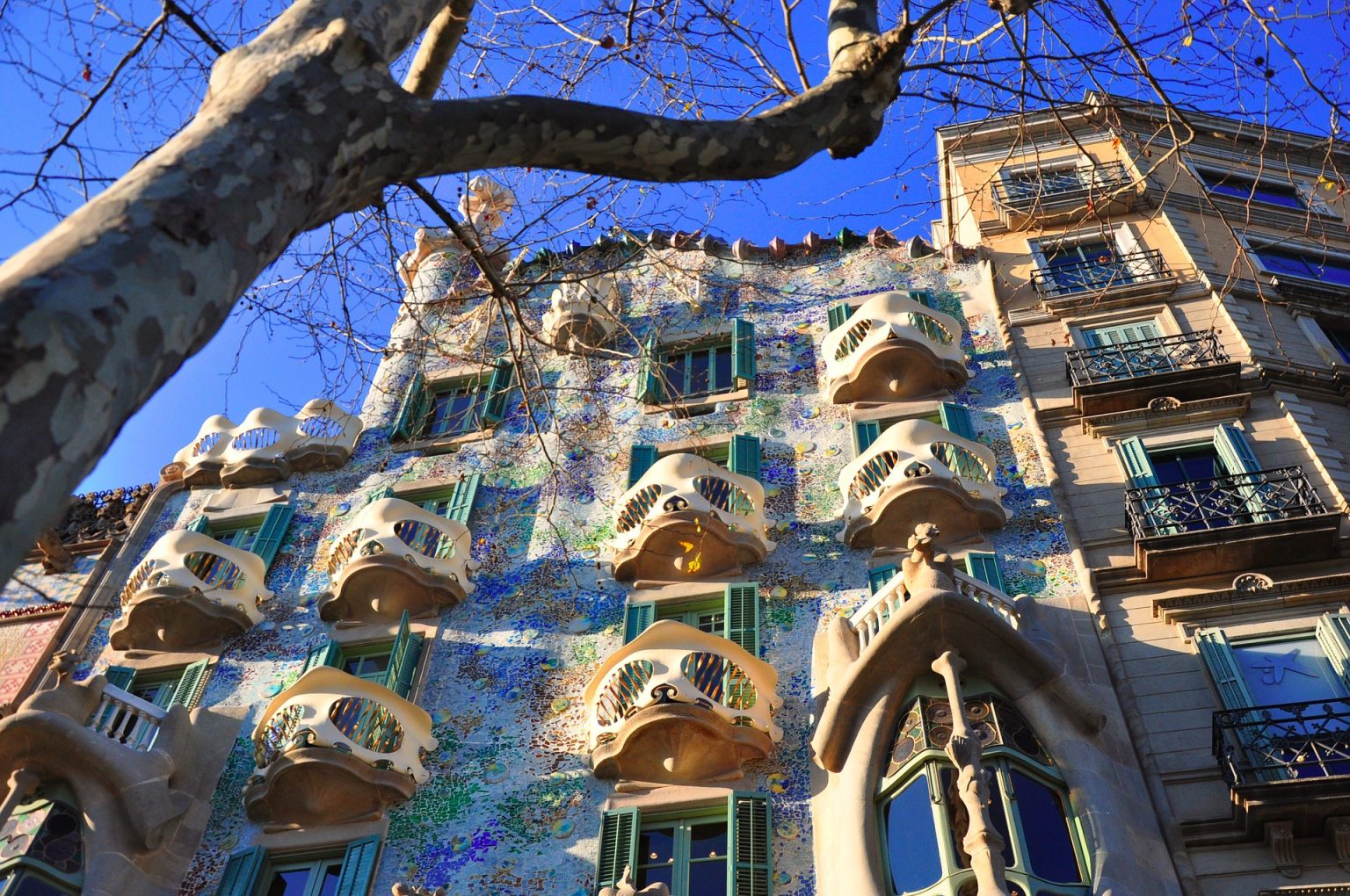
On Barcelona’s famous Paseo de Gracia (Passeig de Gràcia in Catalan) is the stunning Casa Batlló, commissioned by another wealthy businessman Joseph Batlló. Like Güell, Batlló also gave Gaudí complete creative freedom to design his family home.
Gaudí didn’t hold back — he delivered on modernism and symbolism.
There are two interpretations of what the façade of Casa Batlló is meant to represent. Most people believe it symbolizes the legend of Saint George (Sant Jordi in Catalan), the patron saint of Catalonia. The legend says that Saint George slayed a dragon threatening to destroy the village and devour the sacrificial princess. The roof resembles the body of the dragon, the tower topped with a cross the handle of Saint George’s sword, and the bone-shaped columns outside the ground floor the bones of the dragon’s victims.
But some people think that Gaudí was just playing with the shapes and colors you’ll find in an aquatic landscape. You’ll have to visit Casa Batlló to decide what you see in the exterior design.
Why you should visit: Casa Batlló is another example of Gaudí’s belief that the beautiful should also be functional. Rather than demolishing the existing building like Batlló wanted, Gaudí convinced him that a renovation was all that was needed to transform it into a dream family residence.
What to look out for: Once you step inside, take a minute to note what the design and colors in the entrance hall make you feel. Does it feel like you’re underwater? That’s likely what Gaudí was going for. Don’t leave without taking a picture on the roof terrace that, characteristic of Gaudí, looks like a dragon’s back.
How to visit: Casa Batlló is open every day from 9 a.m.-10 p.m., and each visit is timed to be approximately 1 hour and 15 minutes.
Centrally located in Barcelona’s Eixample neighborhood, Casa Batlló is easy to reach by public transportation:
- Metro: L2, L3, and L4
- Bus: H10, V15, 7, 22, and 24
4. Casa Milà
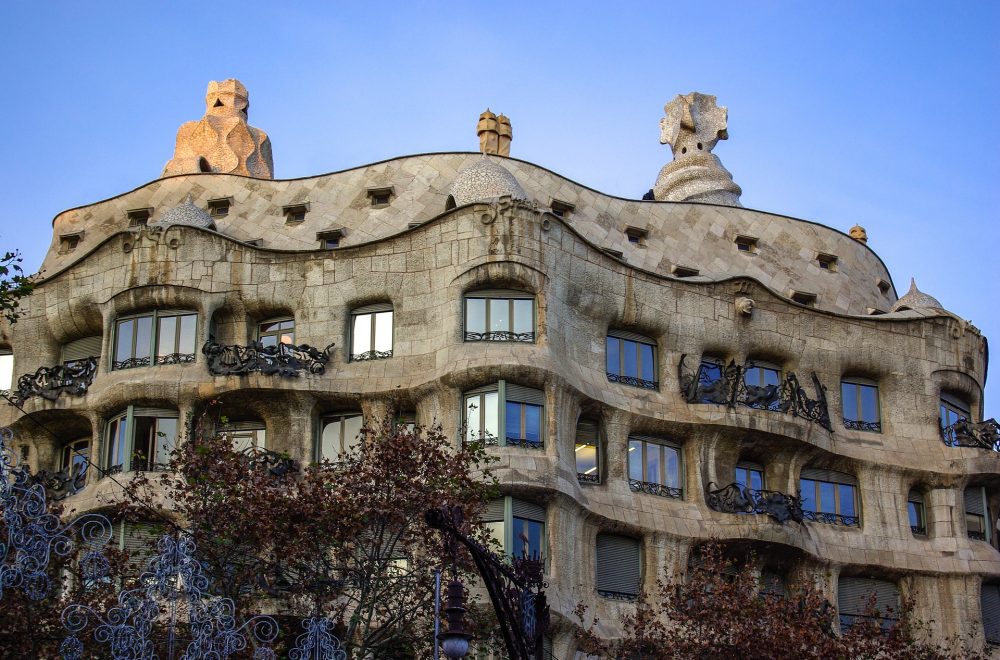
Casa Milà is also popularly known as La Pedrera, meaning “stone quarry” in Catalan, because of its resemblance to a cliffside. Some accounts think Gaudí intended for the exterior to look like a snowy mountain, so a stone quarry, perhaps, isn’t too far off.
This was the last commissioned work Gaudí completed before he began the Sagrada Família. The project was controversial, as Gaudí’s design went well over budget and against building codes. He even quarreled with the Milà family about the fees he was charging.
Casa Milà was neglected for many years until it was declared a UNESCO World Heritage site in 1984, then restored to its original state in 1996.
Why you should visit: This might be the Gaudí building most obviously inspired by nature. Some of the architect’s best ornamental and functional innovations are on display.
What to look out for: The chimneys on the Warrior Rooftop carved to look like warriors guarding the building. The rooftop is also a feat of engineering for its 360-degree views of Barcelona. You also don’t want to miss the Whale Attic with its 270 ceiling arches that look like the skeleton of a whale.
How to visit: Casa Milà offers several experiences for visiting the house, including nighttime and sunrise options.
Located on Passeig de Gràcia, it’s easy to reach the house by public transportation:
- Metro: L3, L5
- Bus: V15, V17, H10, H8, 7, 22, 24, 6, 33, 34
5. Palau Güell
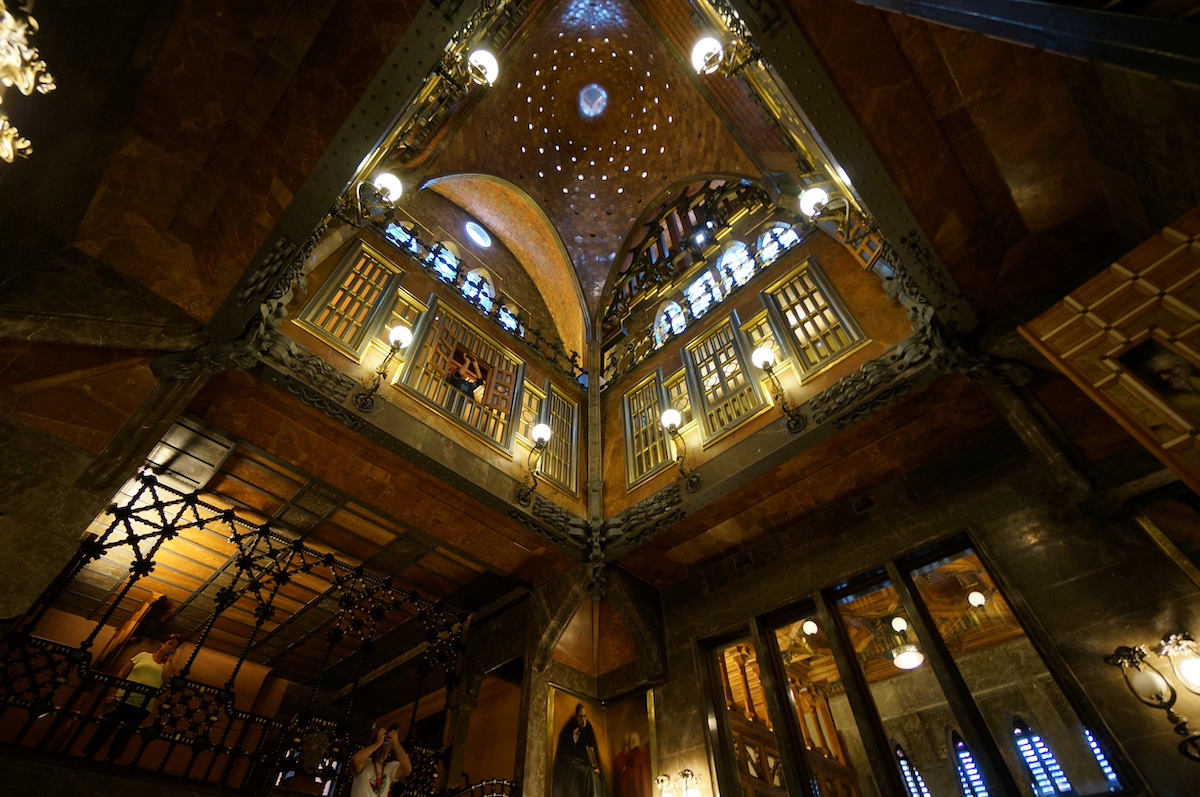
Credit: Andrew and Annemarie / CC BY-SA 2.0 DEED
If Sagrada Família looks like a fairytale castle, then Gaudí’s Palau Güell looks like a castle on a dark and stormy night. Before Park Güell, Gaudí was commissioned by Eusebi Güell to build his family home, located just off of Las Ramblas in El Raval.
Raval was an interesting choice for Güell to locate his residence, as most wealthy families were moving to Eixample in the late-19th century, but it’s clear that Güell was as unique as the architect he put so much faith in.
Why you should visit: From the outside, you might not think Gaudí’s Palau Güell is anything special. On the inside, however, it’s one of the most lavishly-decorated houses he’s ever worked on. There’s a reason why it’s “Palau Güell” and not “Casa Güell.”
What to look out for: The elaborate iron work on the main doors is extraordinary, but the highlight of Palau Güell is the music room with its grand organs and beautiful murals. This space would have been dedicated to social occasions.
How to visit: Palau Güell is closed on Mondays and opening hours vary by season. Tickets can be purchased online or in person.
You can get to Palau Güell by metro or bus:
- Metro: L3
- Bus: V13, 59, 91, 120
6. Casa Vicens
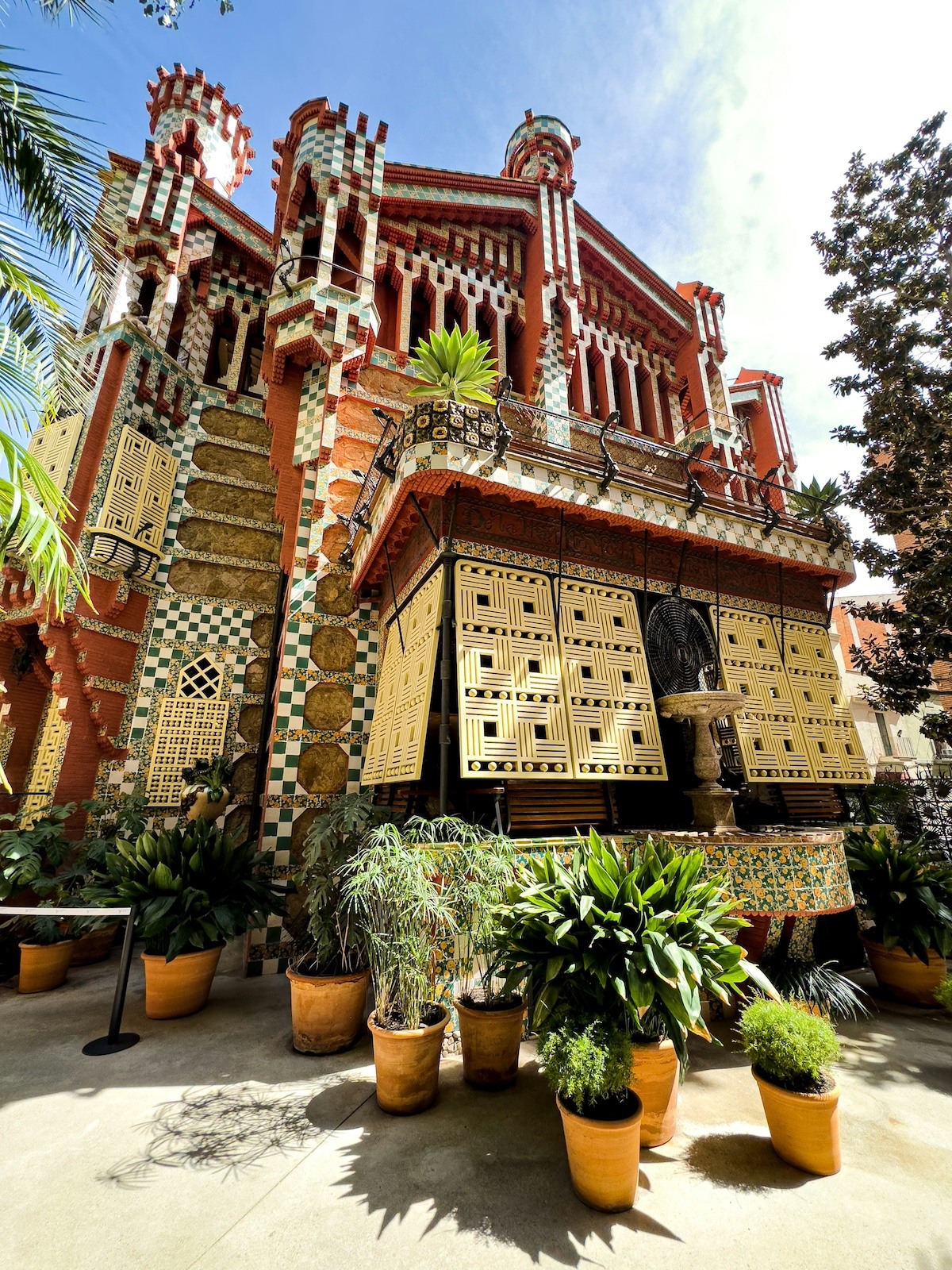
You have to walk a bit through the narrow streets of Gràcia to find Casa Vicens, which means that it’s less crowded and easier to get into than Gaudí’s other houses. It was actually his first commissioned work, and it paved the way for all his later masterpieces.
Gaudí was commissioned to design a summer garden home for the Vicens family in 1883. What you see today is the original construction completed in 1885, an extension designed by Joan Baptista Serra de Martínez in 1925, and a lovely garden area that brings the building to life.
Why you should visit: Casa Vicens is a house of firsts! Because it was his first major commissioned work, you’ll see how Gaudí was laying the foundations of his aesthetic room by room.
What to look out for: See Gaudí’s first accessible rooftop, where residents of the house could go to contemplate life away from it all. But it’s not just an amazing vantage point to see the city. Gaudí designed it to be functional, too, with curved terracotta tiles for collecting rainwater.
How to visit: Reserve a ticket online and arrive 10 minutes before your scheduled time. You’re welcome to tour the museum on your own or see it with a guide. Either way, there’s no need to rush — you can see the house at your own pace.
Public transportation is the best way to reach Casa Vicens:
- Metro: L3
- Bus: 22, 24, 27, 87, 114, H6, V17, D40, N4
7. Bellesguard Tower

Credit: Josep Bracons / CC BY-SA 2.0
Bellesguard Tower is a little-known work by Gaudí that he created as an homage to the Middle Ages. Located in the quiet neighborhood of Sarrià-Sant Gervasi, the tower is far from Gaudí’s other crowded tourist attractions.
This early work of Gaudí’s was started in 1900 and took nine years to complete. Exploring Bellesguard Tower is a great way to see how he developed as an architect.
Why you should visit: Built on the ruins of a medieval palace dating back to 1408, Gaudí interpreted Gothic style in his own way with its large portal and long windows. It’s also an example of Gaudí’s ability to blend his buildings with their natural surroundings.
What to look out for: The contrast between the tower’s bright interior with its dark façade. You might also notice some architectural solutions that Gaudí used Bellesguard Tower to test out before applying them to the Sagrada Família.
How to visit: Bellesguard Tower is open Tuesday-Sunday from 10 a.m. to 3 p.m. Public transportation options include a combination of metro and bus lines:
- Metro line L7 and Bus 196
- Bus V15 and Bus 196
- Bus V13 and Bus 196
What to look for in Gaudí’s architecture
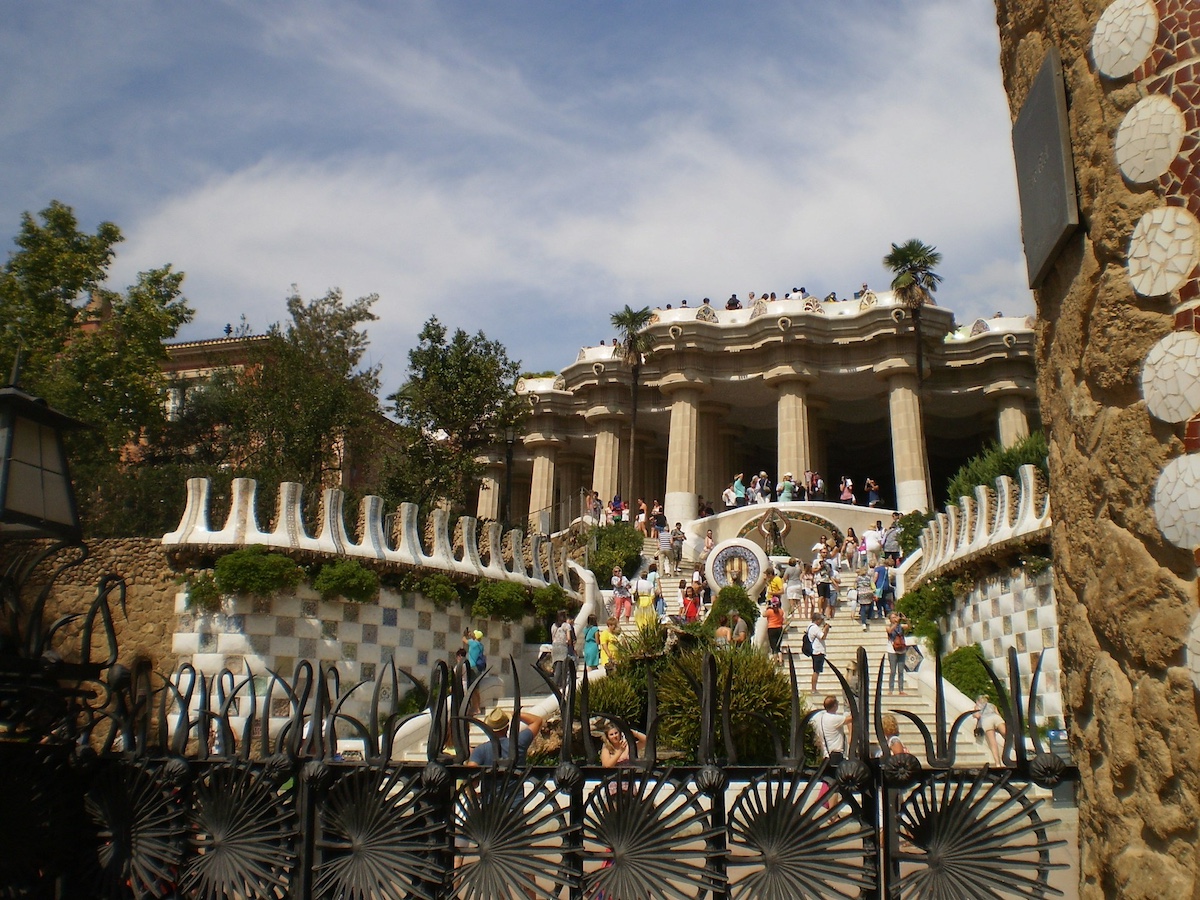
When exploring Gaudí’s architecture around Barcelona, there are recurring themes and techniques that are fun to spot. Here’s how to find them.
A connection to nature
In all of Gaudí’s work you’ll find designs inspired by and mimicking nature. In the Sagrada Família, for example, columns have a double twist shape that can be seen in certain species of plants.
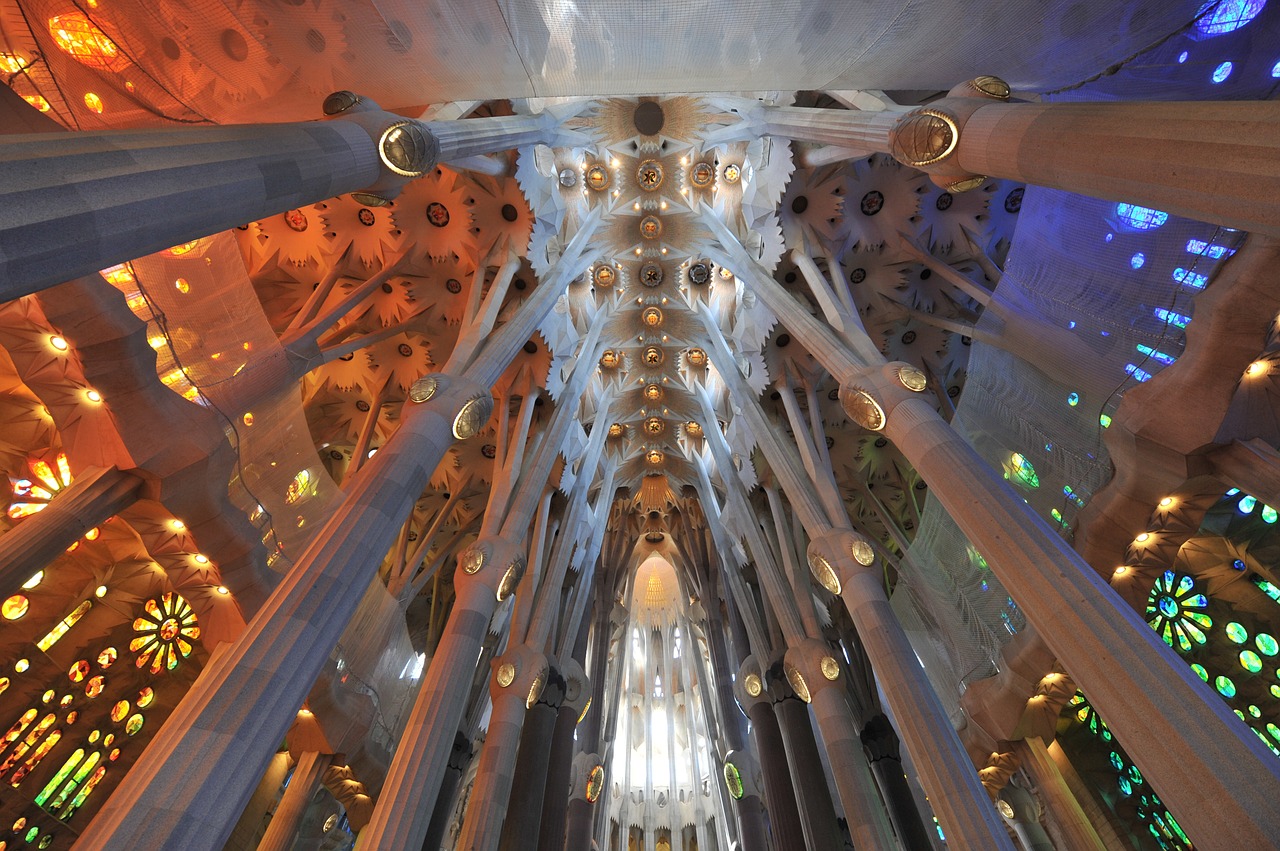
At Park Güell, structures like the large columns of the Hypostyle Room look like palm tree trunks and don’t follow a straight line because that wouldn’t be “natural.”
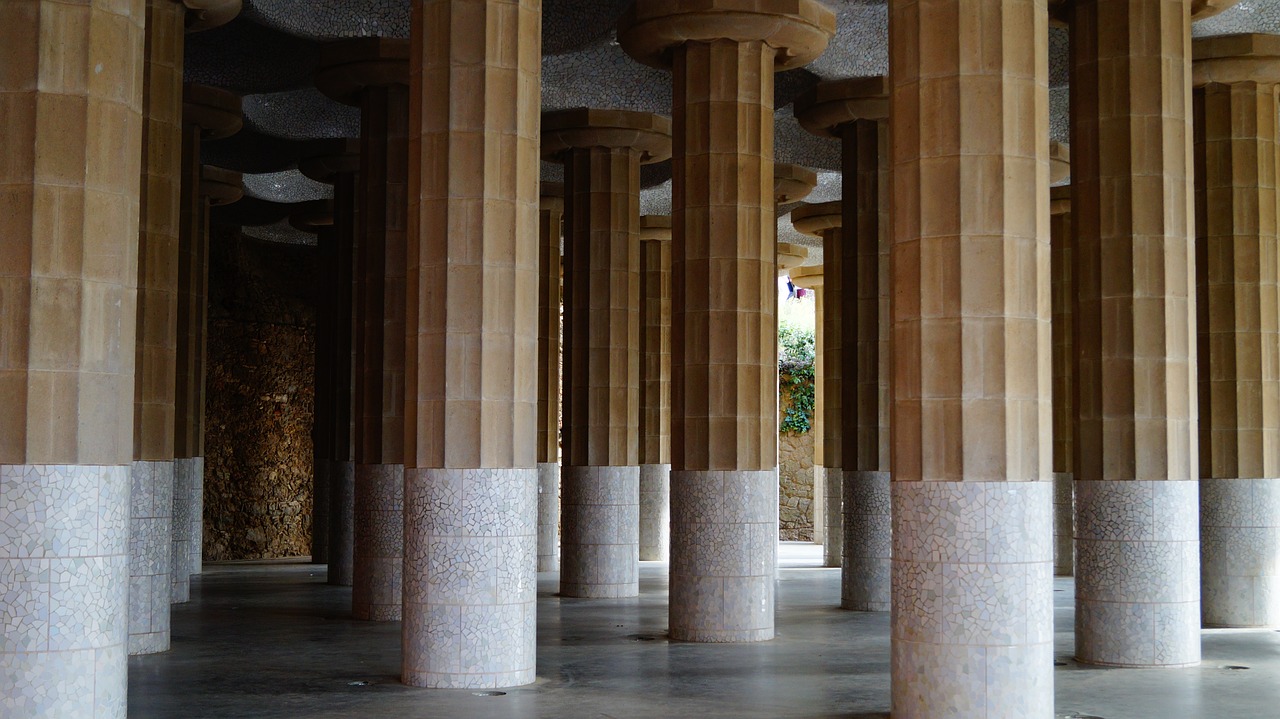
An attention to dragons
Dragons or serpents are popular creatures that appear in Gaudí’s architecture like El Drac on the Dragon Stairway at Park Güell.

The roof of Casa Batlló is also thought to be shaped like the mythic dragon who threatened the city of Barcelona in the story of St. George. As the legend goes, St. George defeated the dragon, and the blood it spilled turned into roses.
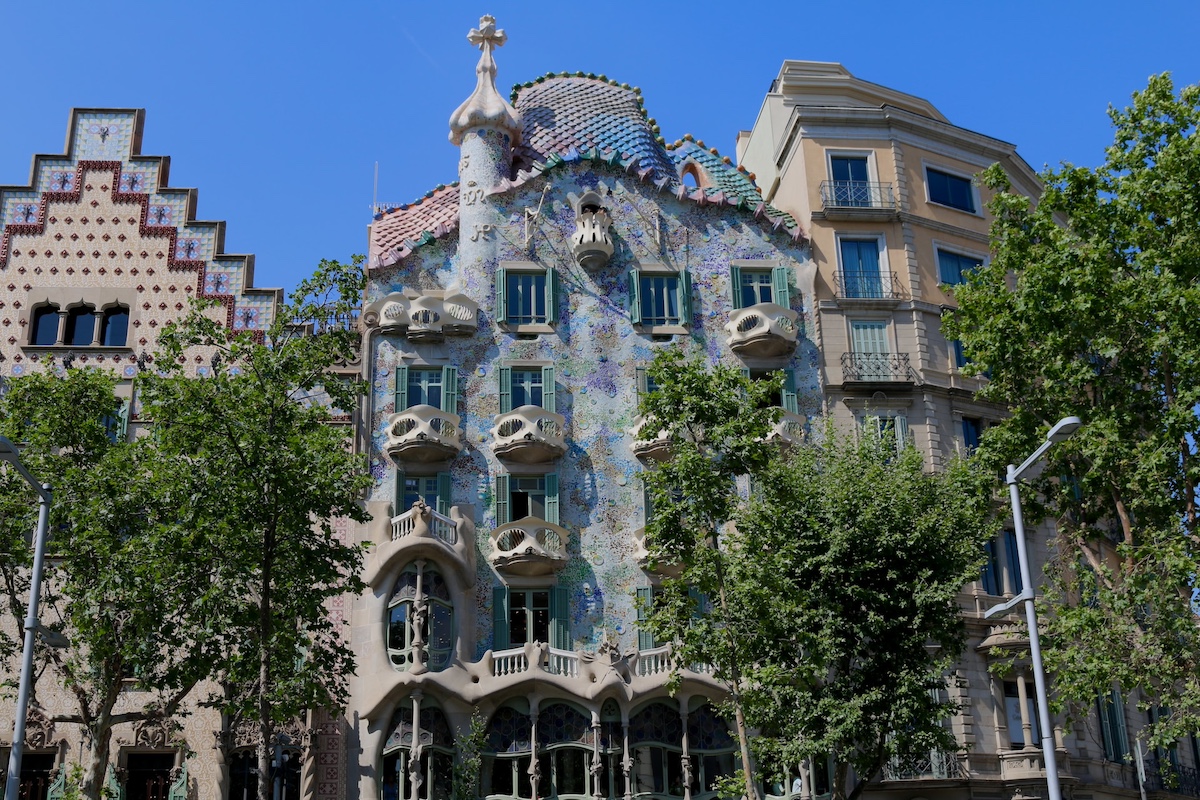
Broken mosaics
Gaudí’s “trencadis” technique involves breaking colorful mosaic tiles into shards to decorate everything from the façades of his houses to the famous serpentine bench at Park Güell.

Take a tour of Gaudí’s Barcelona
Most of Gaudí’s modernist buildings are no longer used as they were intended, but his stunning architecture impresses all the visitors who travel to Barcelona to see them.
From discovering the secret façades of the Sagrada Família to comparing the unique styles of all of Gaudí’s houses, you’ll get a deep dive into the Catalan architect’s work from a local expert on our Gaudí Architecture Walking Tour.